The Best Microphones For Streaming in 2024
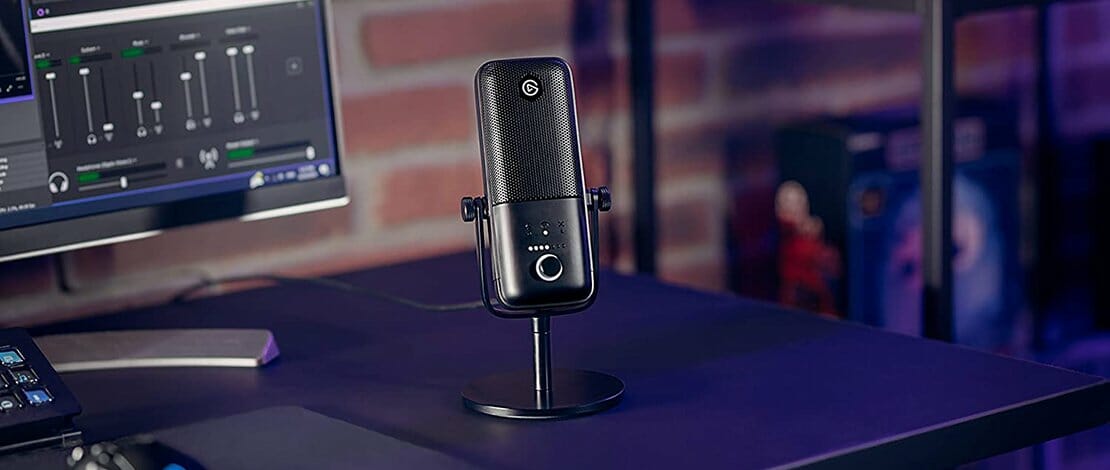
A quality microphone, along with a webcam, is the base of every streaming setup and the most important part of every podcast setup. While headset microphones are good enough for casual gaming and voice chat, you’ll need something better if you want to stream, record videos, or run a podcast. The thing is, not all standalone mics are equal. Finding the best microphone for streaming can be a pain, especially if you don’t know much about mics.
Luckily, the list below includes some of the best microphones for streaming you can get right now. We have crowd favorites, overachievers that pack lots of bang for the buck, and a couple of budget models. If your next mic isn’t among our picks scroll past the list and check out our streaming mic buying guide, it should help you find just the mic you need.
Best Microphones For Streaming
Blue Yeti X Professional Condenser USB Microphone
The Best Streaming Microphone For Most Users
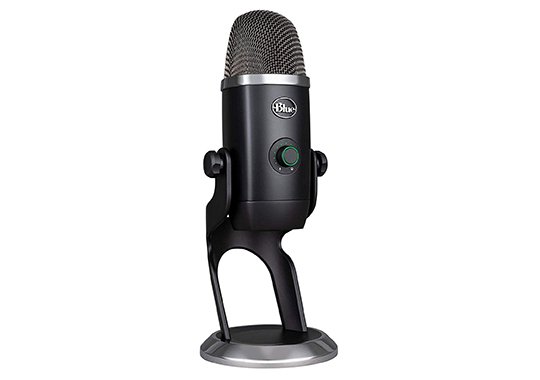
- Type: Condenser (Four Condenser Capsules)
- Pattern: Multi-Pattern (Cardioid, Omnidirectional, Bidirectional, Stereo)
- Sample/Bit Rate: 48 kHz, 24-bit
- Interface: Micro-USB
- Other Features: Gain Knob, Headphone Jack For Monitoring
The Blue Yeti X is the successor of the extremely popular Yeti mic that includes several upgrades the biggest of which is the gain control. The microphone is well-built and comes with a pretty basic stand that’s good enough for casual use. It offers semi-professional recording quality that sounds very crisp and while not perfect, it’s excellent for a non-studio mic.
The gain control can be pretty handy for eliminating sudden background noise on the fly and the LED light pattern encircling the gain knob shows how loud your voice is, allowing users to reduce gain in case there’s clipping. The mic also includes a 3.5mm jack for monitoring your voice and a set of four pickup patterns (stereo, omnidirectional, cardioid, and bidirectional) which can be switched around with a toggle on the back of the Yeti X.
The mic is fairly easy to set-up. Just plug-in the MicroUSB (ouch) cable into the mic (Micro-USB port is located at the bottom of the mic) and then into your PC and that’s about it. The mic comes with the excellent Yeti Voice software that offers a ton of features and is an excellent addition to the whole package. The Blue Yeti X is great for streaming, voice recording, and podcasts, no matter if you’re doing them solo or with guests. It’s a bit pricey, it uses a Micro-USB port instead of USB-C, and is a bit chunky but high recording quality, ease of use, and the excellent Yeti Voice software make it the best streaming mic for most users.
- Excellent Recording Quality
- Great For Both Streaming And Podcasts
- Easy To Set-Up And Use
- Comes With A Gain Knob
- Four Pickup Patterns
- Uses Micro-USB Instead Of USB-C
- Pricey
HyperX QuadCast
Excellent Multi-Pattern Streaming Mic Selling At A Competitive Price
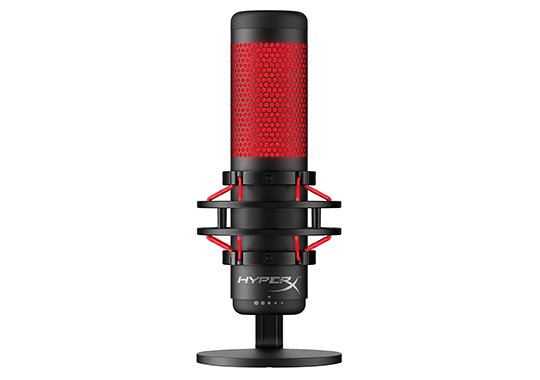
- Type: Condenser (Three Condenser Capsules)
- Pattern: Multi-Pattern (Cardioid, Omnidirectional, Bidirectional, Stereo)
- Sample/Bit Rate: 48 kHz, 16-bit
- Interface: Micro-USB
- Other Features: Gain Knob, Headphone Jack For Monitoring
The QuadCast from HyperX is a competitively priced multi-pattern USB condenser microphone that does lots of things right. It has a solid build quality, especially the quality of the mic body. The design includes soft padding behind metal gratings. The mic features a gain knob for tweaking the sensitivity. The mic also comes with a neat mute touch sensor on the top of the body, allowing users to mute their voice extremely fast and easy. The mic’s also compatible with the PS4, which might matter to console streamers.
The QuadCast comes with four pickup patterns to pick from, with a knob on the back on the mic allowing users to switch patterns on the go. Finally, the sound quality is pretty good and of similar quality compared to equally priced streaming microphones. The mic features reddish lighting inside the body that can be turned off if you find it distracting. When turned on the light’s up as long as the mic’s picking your voice. Press the mute button and the light will shut down.
While the lighting might bother some users, others will value it as a reminder when they’re recorded. As for the interface, the mic uses a Micro-USB port, which is a disappointment to see on a relatively expensive streaming mic. Another slight minus is the fact that the mic boosts sibilants ever so slightly, which can be adjusted in the software. Overall, the HyperX QuadCast is a pretty solid streaming mic that offers lots of its price.
- Includes Gain Knob
- Features Four Pickup Patterns
- Pretty Good Recording Quality
- Big Mute Pad On The Top Is Very Handy To Have
- Competitive Price
- Some Users Might Find The Mic’s Red Light Distracting
- Uses Micro-USB Port Instead USB-C
Shure MV7
A True Successor to the Shure SM7B
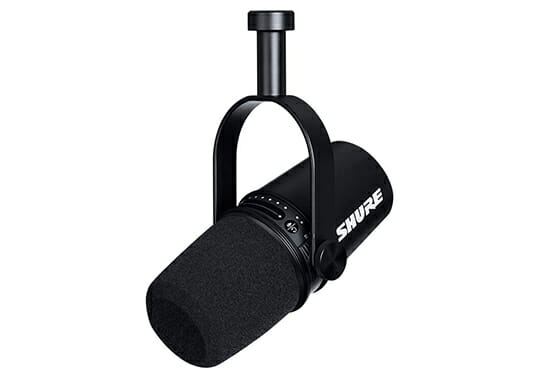
- Dynamic microphone
- Unidirectional polar pattern
- Quick-mute button
- Dual output mode (XLR & USB)
- 44.1/48kHz sample rate
When it comes to streaming microphones there is no other mic quite as popular as the legendary Shure SM7B. As with everything in the tech market though, the SM7B did have certain quirks like for example needing a lot of power to output enough gain, therefore, Shure decided on a successor – the MV7.
The MV7 is a USB/XLR dynamic microphone (unlike most other USB condenser microphones) which is easier to drive than the older model making it a lot more practical for most users out there that do not have specialized audio hardware. Because of the specific design the MV7 does an excellent job at being focused on your voice allowing for extreme clarity during your streams.
The MV7 has a dual output with both USB and XLR which still allows you to have analog recordings if you do have the necessary hardware adding a bit of flexibility to the overall package. The mic has a touch panel with controls that allow you to adjust your gain, monitor your volume, and mute your mic if necessary all from one place which some might find convenient and some might find finicky.
As with most studio-grade microphones, you can also monitor your voice with headphones as you are recording, allowing you to tweak the sound of your mic live. For extra customizability, you can also use the ShurePlus MOTIV app that allows you to further tweak your microphone settings by selecting the distance between you and your mic and selecting different tones for your audio output.
Overall this is a great streaming microphone for both beginners and seasoned veterans alike which allows for a wide range of hardware to be used in achieving the best sounding streaming possible.
- The MV7 allows both for digital and analog voice recording
- The recording capabilities of the MV7 are without a doubt phenomenal
- Allows for further customization with the ShurePlus Motiv
- Touch panel controls and monitoring
- No USB Type-C connection for a premium microphone
- For full customization of your sound, you will still need to use the XLR connection into a mixer
- Physical buttons for controls would have been a better choice for such an expensive product
Elgato Wave:3
Great But Pricey Entry-Level Streaming Microphone
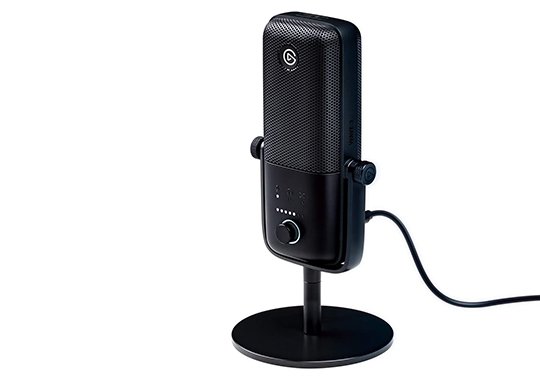
- Type: Condenser (One Condenser Capsule)
- Pattern: Single Pattern (Cardioid)
- Sample/Bit Rate: 96 kHz, 24-bit
- Interface: USB-C
- Other Features: Gain Knob, Headphone Jack For Monitoring
Elgato Wave:3 is a streaming mic from the famous brand known for its streaming peripherals. And while it offers great sound quality for an entry-level streaming mic, the steep price will turn down many potential buyers. The build quality of the mic is great, rugged yet dominated by soft angles. The Wave:3 has excellent recording quality and can record sounds up to 24-bit/96kHz. The sound profile favors higher frequencies and cuts off sub-bass frequencies. This shouldn’t affect the voice recordings and is pretty solid for streaming and doing podcasts.
The mic has only one condenser capsule and comes with only one pickup pattern: cardioid. This is the best pattern for streamers and people doing podcasts solo or without live guests. Still, we would like to see more patterns to choose from at this price. On the flipside, the mic comes with a gain knob that can also be used to control the headphone volume, which is pretty cool. Also, a large touch-sensitive pad on the top is used for a quick mute, another excellent feature for streamers. The set-up is simple and this time the mic features a USB-C port instead of Micro-USB.
The streaming-friendly list of features goes on. The Wave:3 comes with the Clipguard feature that prevents clipping in case you suddenly start screaming from the top of your lungs. Next, the WaveLink app isn’t super powerful but it’s great for controlling the audio sources. It can be used, for instance, to mute your Spotify playlists while keeping everything else on; allowing you to listen to the music without risking a copyright strike. Overall, this is a great mic for streamers but, considering its specs, it’s too expensive for what it offers.
- Great Sound Quality For Streaming And Podcasting
- Features USB-C Port
- Large Mute Pad On The Top Is Super Handy
- Excellent Design And Build Quality
- WaveLink App Has Lots Of Useful Features Such As Clipguard
- Too Expensive For What It Offers
- Just One Pickup Pattern
- The Mic Has Only One Condenser Capsule
HyperX DuoCast
The Middle Brother
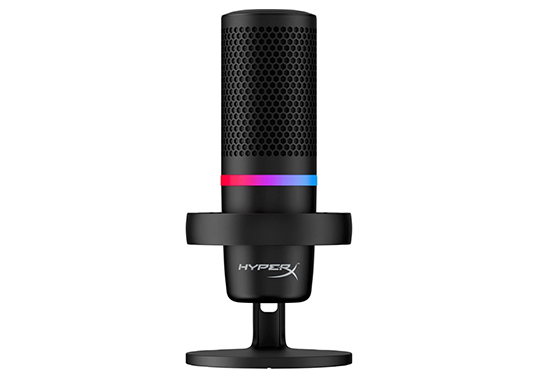
- Condenser Hi-Res 24-bit/96kHz microphone
- Polar patterns: cardioid and omnidirectional.
- Included shock mount, pop-filter, tap-to-mute sensor
When it comes to microphones HyperX has options for different budgets and needs with the SoloCast, DuoCast, and QuadCast microphones. In many cases, the SoloCast is recommended as a solid budget option and the QuadCast is a good all-round higher-end microphone. Still, people tend to forget about the DuoCast which is in many cases more than enough for streaming and gaming.
The DuoCast is a hi-res 24-bit/96kHz microphone with two polar patterns: cardioid and omnidirectional. For most use cases you will want to use cardioid so the microphone focuses on your voice and produces clean recordings without noise clipping through.
The DuoCast has an RGB strip, a gain knob, and a tap-to-mute surface which is a very convenient tool to have. In short, the DuoCast is not much worse than the more expensive QuadCast in terms of functionality.
The main difference is that the DuoCast has two electret capsules vs three 14mm electret capsules on the QuadCast, which for most users will not make a difference in usage. Overall if you are looking for a microphone in the 80-100$ range beating the DuoCast with its quality and slew of features is hard to do.
- The DuoCast is a great middle ground between features and value
- Great looks and functionality with the included shock mount/pop filter/ RGB strip
- No real drop in quality from a full QuadCast
- Plug-and-play device with optional software
- 100$ price range is very competitive and HyperX has to fight options from Rode and Samson which are specialized in producing audio devices
Razer Seiren V2 Pro
The Middle Brother
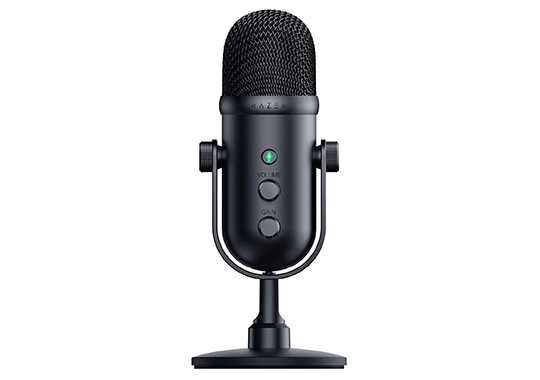
- USB dynamic microphone
- High pass filter and digital analog limiter features
- Built-in shock absorber and mic windsock
- Gain knob and mute button
The Seiren V2 Pro is an interesting choice from Razer simply because this is a dynamic mic which you do not often see marketed for gamers. Most gaming companies use condenser microphones for their greater sensitivity but dynamic microphones tend to sound a lot more intimate and deep, capturing a lot of the audio richness coming from your voice.
Although visually quite simple the Seiren V2 Pro does have a physical gain knob and a mute button which are both useful tools to have at your fingertips. The mic also comes with a built-in shock absorber and mic windsock to help you with not picking up plosives and foreign noises.
Since this is a Pro option the mic comes with a digital analog limiter so you do not clip while yelling in games and a high pass filter activated via Razer Synapse, to eliminate any background humming and buzzing.
In short, if you want a no-fuss great audio solution that can capture your voice cleanly and give you a deep and rich radio voice without having to spend 500+$ on a professional dynamic mic, the Razer Seiren V2 Pro looks like a good choice.
- Dynamic microphones have a distinct sound which many people prefer
- The Seiren V2 Pro has all the necessary features to just plug it in and forget about it
- The construction looks professional and well-built
- Is not fully compatible with Mac devices
Rode NT-USB-Mini
Compact Streaming Mic With a Professional Background
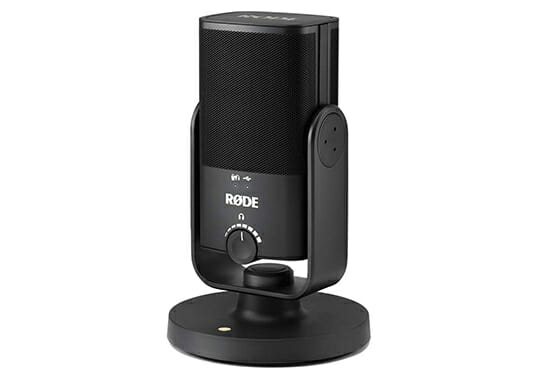
- 24-Bit audio with up to 48kHz
- High-quality condenser capsule
- Built-in pop filter
- Built-in digital signal processing
- Zero-latency monitoring
- 3.5mm port with volume control and studio-grade headphone amplifier
Rode microphones are well-known for the fact that these are great hassle-free studio microphones that you just hook up and use with no issues. The Rode NT Mini is the smaller brother of the Rode NT which focuses more on simplicity and ease of use.
This is a cardioid USB microphone that works at a 24-bit 48kHz sample rate with a frequency range of 20 Hz to 20 kHz. The microphone has a built-in pop filter for reducing plosives and also has built-in digital signal processing like a noise gate and a compressor that can be tuned through the Rode Connect software.
The overall build quality is excellent with a detachable magnetic desk stand, flawless USB outputs, and zero-latency monitoring. On top of that, the 3.5mm output benefits from a studio-grade amplifier and volume control that will allow you to use your headphones for monitoring properly.
This USB microphone is more professionally oriented offering features that are truly useful to someone that cares about audio quality and usability instead of having rainbow lights (sorry RGB lovers).
- Very simple and small but mighty
- Has a lot of features pro’s would actually want
- The build quality is excellent and the performance is stellar
- Can be used without software but the Rode Connect adds a bit of utility to the microphone
- This is a professional studio USB condenser mic therefore it foregoes the usual gamery aspects of streaming audio products
Samson G-Track Pro Professional USB Microphone
Mid-Range Mic Useful For Recording Vocals And Instruments
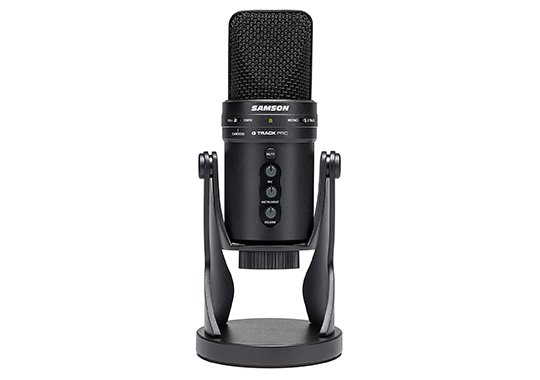
- Type: Condenser (Two Condenser Capsules)
- Pattern: Thee Pickup Patterns (cardioid, figure 8, omnidirectional)
- Sample/Bit Rate: 24-bit/96kHz
- Interface: USB-B
The Samson G-Track Pro is an interesting condenser USB microphone that treads the line between being a streaming and podcasting and amateur studio recording mic. It comes with an additional audio jack for instruments, it delivers crispy clear audio, and it supports up to 24-bit/96kHz recording. The mic also includes additional audio in (1/4’’) for an instrument, allowing you to record vocals and one instrument at the same time while monitoring it all via headphones.
You can switch between mono and 2-track recording (two mono tracks, there’s no stereo option here) in order to get one (voice + instrument) or two audio tracks (voice and instrument). The G-Track Pro includes a master mute button on the front accompanied by three-volume knobs (mic, instrument, and master volume). Do note that you need a pop filter because the mic is pretty sensitive and can easily distort when recording loud vocals.
When it comes to pickup patterns, we have three here. The first is a cardioid, perfect for solo recordings and streaming. The figure 8 pattern is perfect for interviews and podcasts with live guests and the omnidirectional pattern is used for picking up sounds around the room. When it comes to build quality and design, they are solid. The mic is a bit large but looks nice and doesn’t include any unnecessary details. Overall, this is an excellent mic for voice recording and amateur song recording but it’s also pretty good for streaming purposes.
- Excellent Audio Quality
- Allows Voice and Instrument Recording At The Same Time
- Thee Pickup Patterns
- Great For Streamers, Podcasters, And Artists
- Uses USB-B Interface For Connecting To PC
How To Choose A Mic For Streaming
If you’re a newbie to streaming it’s best to just pick a solid budget mic and be done with it. Later, when you get some experience and learn what exactly you need you can do your research and pick just the right streaming mic. Just make sure you have a quality router and a fast internet connection in case you want to stream.
Condenser Vs. Dynamic Mics
First of all, we have to explain the difference between condenser and dynamic mics. First have increased sensitivity and their output is slightly on the warm side. They are great for vocal recordings, the main reason why condenser mics are so popular with streamers, YouTubers, and podcasters. The thing is, their sensitivity can turn against them.
They can pick up even the quietest noises and any sudden sound increase (like hitting a hand against the table during a stream) can sound like an explosion. So, no matter whether your next mic has a gain setting, no matter whether it’s super sensitive or not, just get a pop filter and don’t look back. A pop filter is the cheapest and simplest way to reduce sensitivity and filter certain frequencies.
Dynamic mics, on the other hand, are less sensitive on average and thus are great for streaming since they won’t pick up keyboard strokes, or your cat’s meows in another room. On the flipside, dynamic mics won’t pick up all the details and intricacies of your voice, which shouldn’t bother you if you’re streaming or produce gaming-related content. But if you want a mic not only for streaming but also for voiceover recordings, or for recording yourself while singing, get a dynamic microphone.
RTX Voice Is Amazing For Eliminating Noise
Now, we’ve said and condenser mics are very sensitive and that they can pick up virtually any sound around them, making them less ideal for people without a sound-proof streaming environment. Also, some mics are sensitive enough to even pick sounds from far away. For instance, a mic can pick up the hum of a room fan from another room, even if you made sure there’s no noise in your room and even if you closed the doors.
This is where the RTX Voice arrives and fixes the day. RTX Voice is an app that uses AI and hardware found in Nvidia’s graphics cards to isolate and remove ambient noise in real-time. Yes, this means you can stream from a room filled with people and RTX Voice can pretty much remove noise emanating from your friends.
The app has its limits though. Some noise won’t be removed, only silenced. Also, the louder the background noise, the more robotic your voice will sound. The AI algorithms picking out background noise can be overwhelmed with too much noise, trying to overcompensate and turning your voice into Robocop’s.
RTX Voice is extremely easy to set up and in case you have newest RTX graphics card, feel free to download and use it. This free app can make even the most sensitive mics out there behave great when streaming. This is not a magic wand but it’s amazingly efficient in removing background noise. If you have a too sensitive mic and a required graphics card, check out RTX Voice before deciding to get a new one.
Mic Sensitivity Vs. Mic Volume
The microphone gain means how loud the input of the mic audio channel will be and the gain isn’t the same as the volume. The volume presents how loud the output of the mic (or any other audio channel) channel is. So, if you see a mic volume knob on a mic you’re eyeing know that a volume knob isn’t the same as the gain knob.
Having the gain setting is great because you can decide how sensitive the mic will be. This is handy to have on a condenser mic since these can be pretty sensitive and pick noise that can ruin any livestream. That doesn’t mean the volume knob can do the same. Changing the volume won’t change the fact that the mic is picking all kinds of background noise. It will only make the whole output quieter. You’ll still hear the noise; you’ll just have to turn on the speaker volume higher up to hear it.
Choose A Microphone With A Polar Pattern That Suits Your Needs
Last but not least we have the polar, or pickup patterns. These present the area of the mic that’s picking sounds. For instance, the omnidirectional pattern means a microphone will pick up sounds all around it, at a 360-degree angle. A cardioid pattern, on the other hand, means the mic is only picking sounds that are right in front of it.
This is important when picking your next streaming mic. If you do streams but also like to host guests on your streams or if you’re doing both solo and podcasts with live guests, a mic with only cardioid pattern won’t do. You’ll have to get a mic with a bidirectional pattern because this pattern means the mic is capable of picking sounds from both its sides, which happens when you interview a guest in a podcast for instance.
It’s like when streaming PC games via software and then trying to do the same with console games. It’s not possible, you just have to get a streaming card. So, before you pull the trigger, make sure to know whether you’ll stream or podcast on your own or with other people.